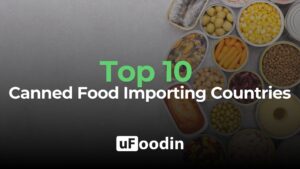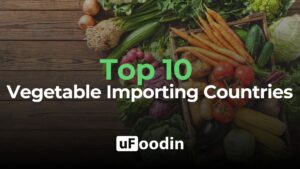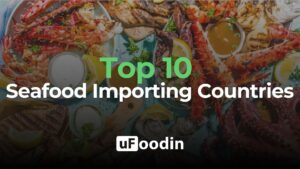
Top 10 Cheese Importing Countries
Cheese has become a universal staple, loved and consumed globally for its versatility and wide-ranging flavors. In 2023, the global cheese market was valued at $95 billion, with imports playing a crucial role in meeting rising demand, especially for premium and specialty varieties. The cheese import market alone accounted for $42 billion, with the top 10 importing countries comprising more than 75% of global imports by value. These markets, including the United States, Germany, and Japan, set the tone for global consumption trends, making them critical targets for suppliers and exporters.
Europe remains at the heart of cheese imports, benefiting from its culinary heritage and vast selection of cheeses. However, emerging economies like China, Japan, and South Korea are rapidly increasing their imports, fueled by urbanization and evolving dietary habits. The rise in consumer preferences for health-conscious and premium products, such as organic and lactose-free cheeses, is further reshaping global demand. This article explores the Top 10 Cheese Importing Countries, analyzing their import dynamics and offering actionable insights for producers and exporters.

1. United States
- Import Volume: Over 450,000 tons annually
- Value of Imports: Approximately $1.8 billion (2023)
- Why It Stands Out: The U.S. leads global cheese imports outside of Europe, driven by its diverse cheese culture, ranging from artisanal varieties to staples like Cheddar and Mozzarella.
- Key Insights: Growth is powered by the increasing popularity of premium European cheeses, alongside the continued demand for pizza cheeses in the foodservice industry.
2. Germany
- Import Volume: Around 400,000 tons annually
- Value of Imports: Approximately $1.6 billion (2023)
- Why It Stands Out: Germany acts as both a major consumer and a gateway to Europe’s cheese trade, importing vast quantities from neighboring countries.
- Key Insights: Soft and semi-soft cheeses like Gouda and Brie dominate the German market, catering to both retail and industrial use.
3. United Kingdom
- Import Volume: Over 300,000 tons annually
- Value of Imports: Approximately $1.2 billion (2023)
- Why It Stands Out: The UK relies heavily on cheese imports to satisfy domestic consumption, with Cheddar and Continental varieties leading the market.
- Key Insights: Brexit has driven the need for diversified sourcing strategies, creating opportunities for non-EU exporters.
4. France
- Import Volume: Around 280,000 tons annually
- Value of Imports: Approximately $1 billion (2023)
- Why It Stands Out: Known as a cheese powerhouse, France also imports to cater to its growing interest in international varieties.
- Key Insights: French consumers appreciate a mix of traditional and foreign specialty cheeses, especially for fine dining.
5. Italy
- Import Volume: Over 250,000 tons annually
- Value of Imports: Approximately $900 million (2023)
- Why It Stands Out: Despite being a top cheese producer, Italy imports cheeses for blending, foodservice, and retail purposes.
- Key Insights: Demand for Mozzarella and specialty blends supports the country’s booming pizza and processed food sectors.
6. Japan
- Import Volume: Around 200,000 tons annually
- Value of Imports: Approximately $800 million (2023)
- Why It Stands Out: Westernization of diets in Japan has propelled cheese imports, with Mozzarella and cream cheese being highly sought-after.
- Key Insights: Japan’s interest in convenience foods and baked goods drives demand for processed cheese.
7. South Korea
- Import Volume: Over 150,000 tons annually
- Value of Imports: Approximately $700 million (2023)
- Why It Stands Out: South Korea’s rapidly growing café and restaurant culture has boosted demand for imported cheeses.
- Key Insights: Functional and fortified cheeses are gaining traction among health-conscious consumers.
8. China
- Import Volume: Around 120,000 tons annually
- Value of Imports: Approximately $600 million (2023)
- Why It Stands Out: China’s expanding middle class is increasingly adopting cheese as a key ingredient in Western dishes.
- Key Insights: Urban centers like Shanghai and Beijing dominate cheese consumption, with a focus on premium imports.
9. Spain
- Import Volume: Over 100,000 tons annually
- Value of Imports: Approximately $500 million (2023)
- Why It Stands Out: Spain’s imports cater to both domestic consumption and the demands of its thriving tourism industry.
- Key Insights: Blue cheese and Cheddar are becoming increasingly popular among Spanish consumers.
10. Netherlands
- Import Volume: Around 90,000 tons annually
- Value of Imports: Approximately $450 million (2023)
- Why It Stands Out: As a major re-export hub, the Netherlands imports cheese for both domestic use and redistribution across Europe.
- Key Insights: Soft cheeses like Brie and specialty blends are highly sought after.
Trends in Cheese Imports
- Premiumization and Specialty Products:
Consumers are increasingly seeking high-quality artisanal cheeses, driving demand for European imports in the U.S. and Asia. - Sustainability and Traceability:
Certifications like organic and fair trade are becoming vital for market penetration, especially in Europe. - Functional Cheese Options:
Health-conscious consumers are showing a growing interest in fortified and probiotic cheeses. - E-Commerce Expansion:
Online platforms are enabling easier access to specialty cheeses, especially in markets with limited retail availability. - Growth in Emerging Markets:
Urbanization and Western dietary trends are fueling cheese demand in Asia, particularly in China and South Korea. - Foodservice Sector Recovery:
Post-pandemic recovery in restaurants and catering is increasing demand for imported cheese worldwide.

Challenges in the Cheese Industry
- Rising Costs:
Inflation and increased shipping costs are putting pressure on cheese prices, impacting affordability in key markets. - Regulatory Hurdles:
Import tariffs and stringent regulations, especially post-Brexit, are complicating international trade. - Climate Change:
Weather disruptions are affecting milk production, the primary raw material for cheese. - Competition from Plant-Based Alternatives:
The growing popularity of vegan cheese is diverting some consumer spending from traditional cheese products. - Market Saturation:
Mature markets like the U.S. and Germany face intense competition, requiring differentiation through innovation. - Supply Chain Disruptions:
Delays and logistical challenges continue to hinder the smooth flow of imports.
The Top 10 Cheese Importing Countries provide unparalleled opportunities for producers to expand their reach and cater to diverse consumer preferences. From the U.S.’s premium cheese boom to Asia’s growing appetite for Western products, each market presents unique avenues for growth.
Platforms like uFoodin bridge the gap between suppliers and buyers, enabling producers to connect with high-potential markets in over 210 countries. With tools for showcasing products, tracking trends, and building long-term partnerships, uFoodin empowers suppliers to navigate challenges and meet evolving consumer demands.
By embracing innovation, sustainability, and technology, cheese producers can not only cater to established markets but also unlock the potential of emerging ones. With strategic planning and support from platforms like uFoodin, the global cheese trade offers limitless possibilities for growth.
uFoodin Editorial Team
Bibliography
- Statista: Global Cheese Import Market Data
- International Dairy Federation: Trade Insights
- MarketWatch: Trends in Global Dairy Markets
- Grand View Research: Cheese Market Forecasts
- Reuters: Post-Brexit Cheese Trade Analysis
- Mordor Intelligence: Specialty Cheese Growth Trends























